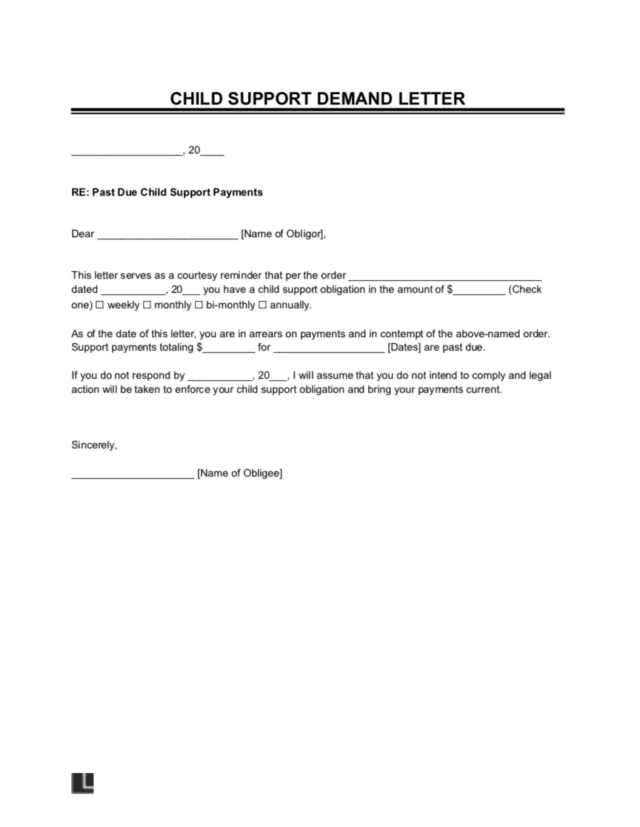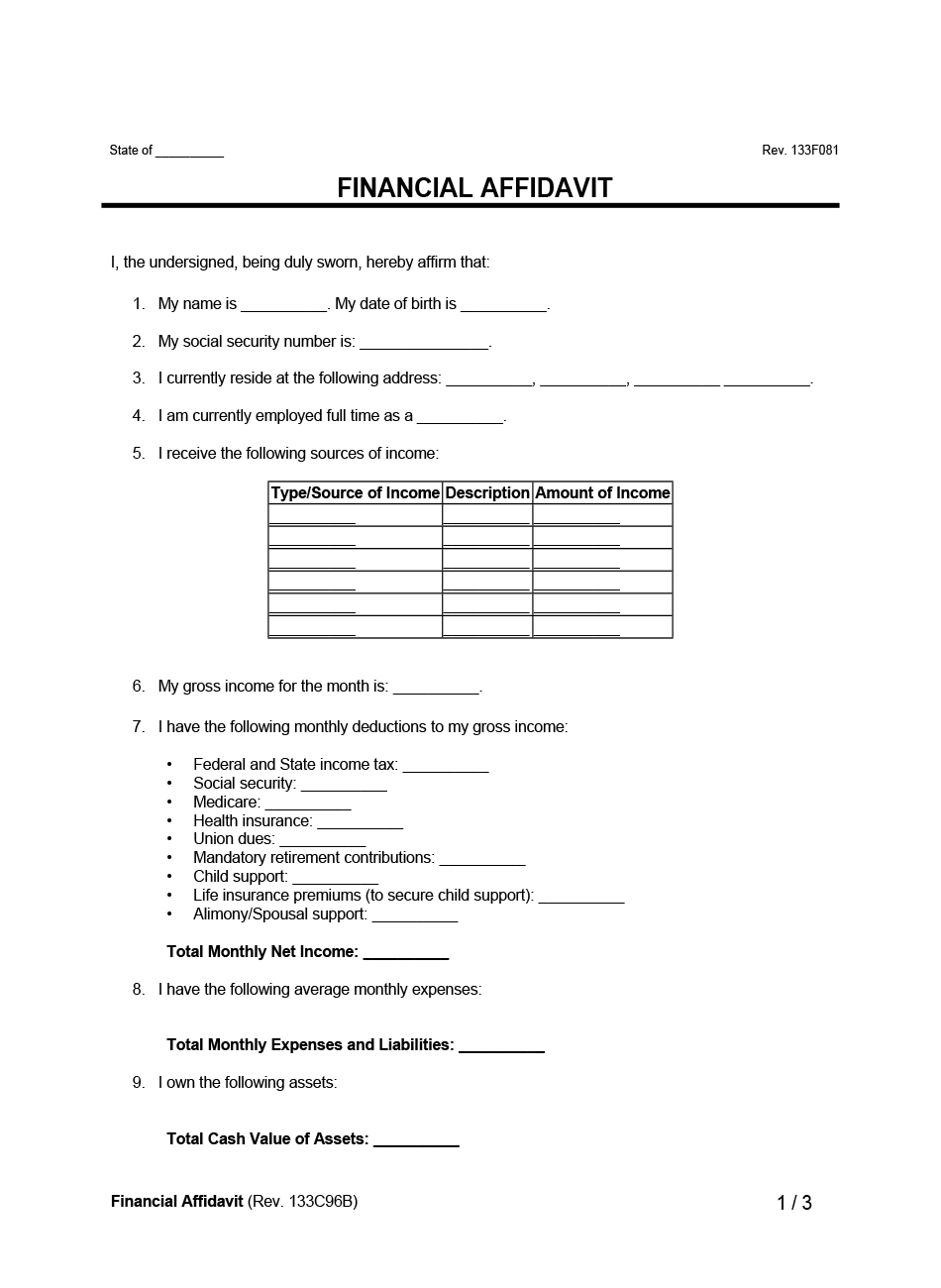What Is a Financial Affidavit?
A financial affidavit is a legal document detailing your financial circumstances. This sworn statement lists your income, assets, debts, expenses, and other financial duties. It also reveals contingent assets, which you may receive in the future.
Courts use this form to make informed choices about things like child or spousal support. To ensure it’s valid, you need to sign it in front of a notary public. If you don’t, the court might not accept it, which could cause delays or unfair decisions. Our financial affidavit form helps you share your finances clearly, giving the court the transparency it needs to rule fairly.
Short-Form vs. Long-Form Financial Affidavits
Some financial affidavits are short and used for simpler situations like uncontested divorces. Others are long and more detailed, often required in more complex cases. The form you use depends on your situation and what the court needs to know.
What Is a Financial Affidavit Used For?
A financial disclosure affidavit shares important details about your financial situation. Courts often need this form to make fair decisions in cases involving property division or debt. Here are some circumstances when you may need to fill out a financial affidavit.
Divorce Proceedings
You may need to fill out a financial affidavit for divorce when you or your spouse file a petition for divorce. This form gives the court a clear picture of each person’s income, expenses, debts, and assets. It helps the judge make fair decisions about things like dividing property, setting alimony, and deciding child support.
In most cases, courts require each person to submit their financial affidavit shortly after filing or responding to the divorce petition. Check your state’s rules to find out the exact deadline.
Other Documents for a Divorce
Fill out a divorce agreement to decide on key matters. Use a divorce settlement checklist to guide the writing process.
Child Support and Custody Cases
A financial affidavit for child support helps the court understand each parent’s financial situation. This includes their income, expenses, and other financial responsibilities. The court uses this information to decide how much each parent should contribute to supporting their child.
Even if the parents were never married, the court may still require both to complete a financial affidavit. It ensures that support amounts are fair and based on what each parent can afford. Parents may also need to update their financial affidavit if they want to change an existing child support order.
Alimony Cases
Alimony usually comes up during a divorce, but it can also apply in other situations. For example, a legal separation, an annulment, or the end of a civil union can result in one partner needing financial support from the other.
A financial affidavit for alimony gives the court a clear picture of each person’s income, expenses, and financial needs. This helps the judge decide if support is needed, how much, and for how long.
Ending a Cohabitation Agreement?
If you and a partner are ending a cohabitation agreement, you may need a financial affidavit to request financial support. This is especially true if your state allows for palimony or similar claims.
Prenuptial or Postnuptial Arrangements
Before signing a prenuptial or postnuptial agreement, both spouses may fill out a financial affidavit. This helps each person understand the other’s income, debts, and assets so they can make fair and informed decisions about dividing property or support if the marriage ends.
Bankruptcy
A bankruptcy court may also request a financial affidavit from someone experiencing bankruptcy. As with family law matters, courts review your assets and debts, income, and expenses to choose the appropriate way to resolve a bankruptcy matter.
Need to File for Bankruptcy?
Use the official Statement of Financial Affairs for Individuals Filing for Bankruptcy to reveal your financial situation.
Legal Aid Requests
A financial affidavit may be necessary if you apply for legal aid or a public defender’s services. The US Constitution guarantees legal representation in criminal cases, even if you can’t afford an attorney [1] . In this situation, a court may ask you to provide financial information to determine whether you qualify for paid legal services.
How to Fill Out a Financial Affidavit
A financial disclosure affidavit doesn’t just list numbers; it creates an honest picture of your financial life for the court. Whether you’re handling divorce, child support, or another legal matter, this form can carry real weight. Taking the time to complete it carefully helps ensure your voice is heard when it matters most. Follow these steps to get started.
1. Fill Out Affiant Information
Fill out your information as the affiant, or the person making the sworn statement. Include your personal information, such as your full name, date of birth, address, and Social Security number.
2. Add Employment Details
If you currently have employment, provide the following details about your position:
- Employment status (full-time, part-time, etc.)
- Your title
- The company that employs you
- Your employer’s address
- Your pay rate and frequency
Name a secondary employer and clarify if you’re self-employed.
3. Describe Other Income Sources
If you receive any other income sources besides your salary or wages, list them on your form. These sources outside your current employment could include child support, alimony, Social Security benefits, unemployment, rental income, or interest from investments.
4. Record Your Gross Income
Record your gross monthly income by adding up all your income sources. Your gross income should be from any source before you account for taxes and deductions.
5. List Your Deductions
Your deductions are the figures you subtract from your gross income every month. Deductions can include the following:
- Federal & state income tax
- Social security
- Medicare
- Health insurance
- Union dues
- Mandatory retirement contributions
- Child support
- Life insurance premiums (to secure child support)
- Alimony/spousal support
State the amount in the affidavit if you have any of these as deductions in your monthly income. Once you know all your deductions, you can subtract them from your gross income to produce your net income. Record this figure in the appropriate blank.
6. Record Your Expenses & Assets
Examples of monthly expenses include:
- Household expenses: Rent or mortgage, real estate taxes, property or renter’s insurance, homeowner’s or condo dues, utilities, and groceries.
- Transportation expenses: Car payment, gas, car insurance, maintenance and repairs, public transit, and parking.
- Personal expenses: Insurance premiums, uninsured medical expenses, clothing, and childcare expenses.
- Loans and other debts: Student loans, car loans, and credit card payments.
Once you add your expenses, record the total in the affidavit. You should also account for your assets, which are things you own that you can convert to cash. List them similarly to your expenses and include their total cash value.
| Category | Examples |
|---|---|
| Income | Salary; Hourly rate of pay; Commission; Overtime; Alimony; Tips; and Bonuses. |
| Other sources of revenue | Government assistance; Rental income; Dividends; Pension; and Retirement income. |
| Assets | Real estate; Family heirlooms; Electronics; Computer equipment; Musical instruments; Precious metals; Collections; Jewelry; Vacation homes; Cars and boats; Motorcycles and ATVs; Motor home; Inheritance; Stocks and bonds; Investment portfolios; Vacation time shares; and Other items of value. |
| Liabilities or debts | Loans; Second mortgages; Lines of credit; Personal loans owed to family or friends; Student loans; Credit card debt; Tax debts; and Judgments. |
| Expenses | Court-ordered child support; Court-ordered alimony; and Bills associated with running a household. |
Classifying Your Finances
If you’re unsure where something belongs, just list it. While the table above separates income, assets, debts, and expenses, don’t worry too much about categorizing everything perfectly. It’s more important to include the information than to leave something out. The court can sort out the details, but only if everything is disclosed.
7. Sign Your Name
You must sign your name before a notary public. The notary will confirm your identity and ensure you understand the purpose of signing the document.
Financial Affidavit Sample
View a free financial affidavit form to understand how to disclose your finances in different scenarios. Then, fill out your own form via our template and download it in PDF or Word format.
What’s Next After Filling Out a Financial Affidavit?
Once you fill out a financial affidavit, you’ll submit it to the court or whatever party requested it. Depending on the information you report, you may need to submit more documentation with your affidavit. This documentation may include recent income tax returns, pay stubs, proof of income, bank statements, or other documents supporting your claims.
Once you submit the affidavit and supporting documents, court proceedings can begin. In many cases, both parties can negotiate certain terms outside of court or during mediation. If they reach an agreement, the court can approve it. Otherwise, a judge will decide how to fairly divide property, assign financial responsibility, or determine support payments. After the court issues its order, both parties must follow it and respond to any required updates or modifications.
Make Financial Disclosure Simple
A financial affidavit ensures fair legal decisions regarding spousal support, child support, and asset division by providing a clear picture of your financial situation. Legal Templates makes the process simple, allowing you to fill out your affidavit at your own pace. Our easy-to-use template ensures that your financial disclosure meets legal standards, helping you move forward with confidence.
Frequently Asked Questions
Is an income and expense form the same as a financial affidavit?
No. An income and expense form is a broader document that’s used as part of a company’s accounting processes, while a financial affidavit is a sworn statement that provides information about someone’s income, expenses, assets, and debts.
Should I fill out a financial affidavit after a car accident?
In general, there’s no legal requirement to fill out a financial affidavit after a car accident. However, it can be helpful if you are part of a lawsuit or car accident settlement. A financial affidavit provides an overview of your assets, which may be considered in determining compensation or settlement amounts.
Are financial affidavits part of the public record?
Financial affidavits may become a part of public records, depending on who you file them with. For example, financial affidavits filed with family law courts often become part of the public record.
Do I have to answer all the questions on a financial affidavit?
Be as thorough as possible when filling out a financial affidavit. Your transparency can prevent delays and show a court you have nothing to hide. Talk to a lawyer if you think an affidavit is requesting irrelevant information.
What happens if you lie on a financial affidavit?
Lying on a financial affidavit can lead to perjury charges, fines, and imprisonment. It may also result in a loss of credibility in court and a loss of legal remedies.





